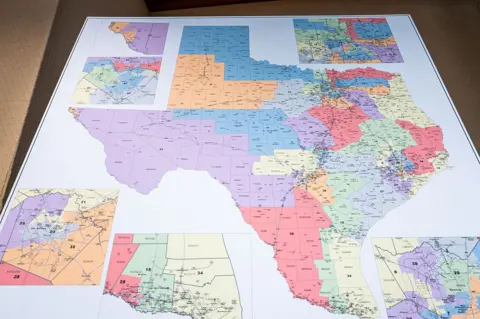 Getty Images
Getty ImagesNorth Carolina has become the latest battleground in a growing national conflict over redistricting as Republicans and Democrats race to redraw congressional maps to alter the balance of power in Washington.
Lawmakers in California and Texas, two of the most populous US states with a combined population of more than 70 million, have already approved redistricting in favor of one political party.
Over the summer, Texas Republicans passed a plan to create five additional congressional seats that would likely favor their party. California lawmakers hit back by approving their own redrawn maps designed to balance Texas' gains. These maps will require voter approval before they can be used in the 2026 election.
This was quickly followed by Missouri, where the governor ordered a special session so lawmakers could work on redrawing a new map designed to add another Republican seat.
And now North Carolina has entered the fray. Republican leaders in the state say they are following “President Donald Trump's call for legislatures across the country to take action to undo Democratic redistricting efforts.”
The political tug-of-war over redrawing electoral maps is likely to intensify as both sides seek to gain some advantage ahead of the 2026 midterm elections.
Here's what you need to know about America's fight over congressional redistricting.
Why is this happening?
The battle began in Texas this summer when the Republican-majority Legislature took the unusual step of reapportioning congressional seats mid-decade – in a deliberate attempt to send more Republicans to the House of Representatives in Washington.
The move comes as Trump pressures Republican-led states to divide their districts to maintain full Republican control of Congress after the 2026 elections.
Republicans currently hold a slim majority in the 435-member House of Representatives. If only a few Democrats win seats from conservatives, it could lead to a shift in control that would likely slow down Trump's legislative agenda in Congress.
The Lone Star State's goal was to add five additional congressional seats, which would favor Republicans.
California responded by redistricting to increase Democratic representation by five seats, in an attempt to undo Texas' move.
Since then, the trend has spread throughout the country. Missouri lawmakers passed new congressional maps in September. Ohio announced plans to do the same, then North Carolina Republicans said they would follow suit.
What is redistribution?
The US House of Representatives consists of 435 legislators who are elected every two years.
They represent districts whose boundaries are determined through processes established by their state governments.
Who draws the lines and how can greatly influence the ideological leaning of a district and its likelihood of electing a Democrat or a Republican.
At the moment, the House of Representatives is on a knife's edge: Democrats only need to capture three more seats to seize control of the chamber.
The president's party historically loses seats in midterm elections.
If Democrats capture the House of Representatives, they could launch sweeping investigations into the president's actions, as Democrats did in the second half of Trump's first term and Republicans did in the final two years of Joe Biden's administration.
 Getty Images
Getty ImagesWhy is everyone talking about redistricting now?
Each member of the U.S. House of Representatives represents a district in their home state. Districts are usually determined by the U.S. Census, which is conducted every decennial to account for state population changes.
But Republicans and Democrats are now fighting to redraw the maps mid-decade to either help or block Trump's agenda. By redrawing districts, each party hopes to gain more seats in the House of Representatives.
The effort in Texas stalled in early August after state Democrats left the state in an attempt to deny the quorum needed to pass a Republican redistricting measure.
Democrats returned two weeks later when California, a Democratic stronghold, announced plans to counter the effort in Texas. Upon their return, the House voted 88 to 52 to create five new seats.
The measure was quickly approved by the Senate and then signed into law by Gov. Greg Abbott.
Democrats and civil rights groups said Texas' new maps would weaken voting rights for minorities, a violation of the federal Voting Rights Act, and filed a lawsuit.
How does redistricting work and is it legal?
Gerrymandering—the redrawing of electoral boundaries to favor a political party—is practiced by both major parties and is legal unless it is determined to be racially motivated.
However, it is highly unusual for a president to publicly support government efforts to create a partisan advantage.
While both Democratic-dominated and Republican-dominated states have faced criticism and legal battles over their U.S. House maps, legislators have rarely so clearly acknowledged the partisan intentions behind their actions.
Critics argue that the process allows politicians to choose their constituents rather than voters choosing their elected officials.
This can result in very wonky maps that lump certain groups together regardless of their geographic proximity.
In 2019, the Supreme Court stripped courts of their power to block political gerrymandering.
“Federal judges are not licensed to redistribute political power between the two major political parties,” Chief Justice John Roberts wrote in his ruling at the time.
California vs Texas
Redistricting could have major implications in the 2026 midterm elections and has become a pressing issue for state legislators.
Illinois, New York, New Jersey, New Hampshire and Maryland are among the Democratic-led states discussing countermeasures to the Texas plan.
Indiana and Florida are also now considering redistricting to increase Republican representation in Washington.
Missouri Gov. Mike Kehoe, a Republican, said the new map approved by lawmakers “will ensure that our districts and Constitution truly put Missouri's values first.”
California Gov. Gavin Newsom, whose state is led by Democrats, has vowed to “fight fire with fire” as he reiterates efforts to boost his party's chances of winning.
But the process has been slow in California because of a 2008 law designed to make the process less partisan.
On Aug. 21, the California Legislature voted to place the new maps on the November special ballot to give voters the opportunity to decide whether they should change the map.
The November vote could be contentious because voters previously approved a process that leaves it up to a nonpartisan commission to decide how the voting line should be drawn.
Utah, whose four counties are Republican, has been ordered by a judge to redraw its maps ahead of the midterm elections.
A Utah judge ruled that lawmakers ignored a voter-passed rule that prohibits politicians from “favoring or favoring sitting elected officials or considering partisan political information” when drawing their maps.
The move is expected to ultimately benefit Democrats in Salt Lake City, the capital of the Beehive State.
New York wants to enter the fray, but the process there takes even longer because the state constitution would need to be changed.
“In New York, we will face Trump’s legal insurrection head-on,” New York Gov. Kathy Hochul vowed.
“We will meet him on the same field and beat him at his own game.”
States where Republicans control most of the government may have an easier time redrawing their maps, experts say.
Democratic-controlled states have more legal and constitutional barriers designed to protect against political gerrymandering.
Several small states, including Delaware and Vermont, only gain one seat in the House of Representatives, making them virtually irrelevant to the current fight.
But with so much at stake, even these smaller states could end up getting in on the action.









